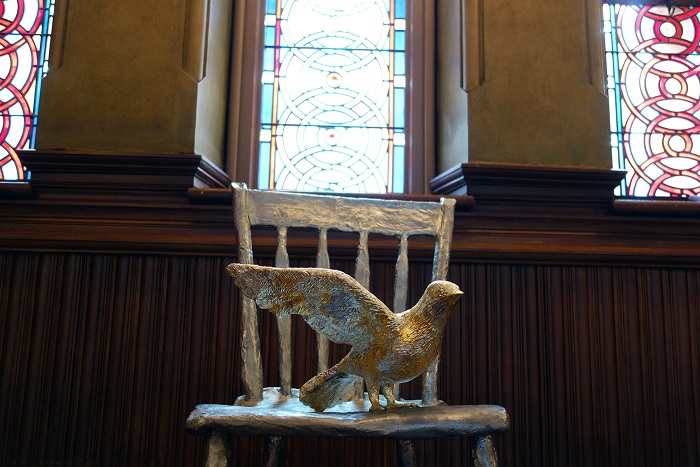After collaborating on the starry window that presides over the Museum at Eldridge Street, Kiki Smith returns with a site-specific installation of sculptural work.
Installation view of Below the Horizon: Kiki Smith at Eldridge at the Museum at Eldridge Street (all photos by Allison C. Meier for Hyperallergic)
Before the restoration of the Eldridge Street Synagogue, birds flew in through holes in the roof. The animals roosted in the 19th-century structure that was once a haven for Eastern European Jews on Manhattan’s Lower East Side, but it had fallen into a decline because of a shrinking membership and its leaking sanctuary was closed off half a century ago. Now three sculptures by Kiki Smith recall this moment of the synagogue’s decay, with gold leaf-covered birds perched on aluminum chairs. They’re installed on the third level women’s gallery of the synagogue — opened as the Museum at Eldridge Street in 2007 — with one suspended up by the rose window, soaring in the kaleidoscopic light.
The opposite stained-glass window, with its field of stars against a fragmented landscape of blue, was created by Smith with architect Deborah Gans and installed in 2010. It replaced the industrial glass blocks, placed by the struggling congregation in 1944, that had filled the void. With no record or photographs of the original window to refer to, the museum opted for a contemporary interpretation instead of a recreation. Now it is hosting 50 pieces of Smith’s work in Below the Horizon: Kiki Smith at Eldridge, the first site-specific exhibition to use all three floors of the building.
Installation view of Below the Horizon: Kiki Smith at Eldridge at the Museum at Eldridge Street
“Kiki was so attuned to our historic space when she and Deborah Gans designed the new rose window, that we were eager to bring her back and see how she would respond to other parts of the building,” Nancy Johnson, archivist and curator at the Museum at Eldridge Street, told Hyperallergic.
Down in the main sanctuary, dozens of flat wooden sculptures are lined up in long cases below the windows. Visitors can enter the pews, with their floors grooved by decades of rocking motion by praying congregants, and examine their colorful hand-painted texture. Some are inquisitive felines named for characters from T. S. Eliot’s “Old Possum’s Book of Practical Cats,” others are disembodied hands grasping hearts, symbols of charity. “For the small sculptures shown in the main sanctuary — wood images of hands holding hearts, birds, cats, and a woman’s face that looks like her own — she thought that their painted surfaces would converse nicely with the colors in the stained glass windows that line the walls, and she was absolutely right,” Johnson said.
Installation view of Below the Horizon: Kiki Smith at Eldridge at the Museum at Eldridge Street
In their work on the stained glass window, Smith and Gans demonstrated a similar sensitivity to the historic space. Down on the first floor, in the museum’s Michael Weinstein Art Gallery that opened in 2016 for temporary exhibitions, is a small installation of materials related to the stained glass window. Stretching 16 feet in diameter, the window presides over the ark on the east end of the sanctuary. Its around 1,200 of pieces of traditional stained glass, contained on laminated sheets of clear glass with silicone, feature a constellation of five-pointed stars and a central Star of David. From a distance, it is a vortex of celestial shapes; closer examination reveals that the five-pointed stars and shades of blue echo the original painted interior, and the Star of David recalls the traditional decoration of the synagogue.

The rose window by Kiki Smith and Deborah Gans at the Museum at Eldridge Street
Below the Horizon is a continuation of Smith’s response to the building, its architecture, its past, and its present. The exhibition draws attention to the spirituality of the place, but conveys ideas of the sacred through visuals of the body and nature. The Museum at Eldridge Street has been open just over a decade, and the intervention of art reinvigorates the space. Smith’s elegant sculptures and prints — with their thoughtful rapport with the synagogue — are a harmonious fit, and it will be interesting going forward to see how the museum continues to experiment with exhibitions. Although a relatively young museum, the deep history of the synagogue — one of the first built by Eastern European Jews in the United States — makes it an incredibly rich setting for art. Smith’s show demonstrates that it’s possible to be respectful to this heritage, while engaging with contemporary expression.
“Since 2010, Kiki Smith’s work has been part of the fabric of our building,” Johnson stated. “For some of our visitors who are not well-versed in contemporary art, Kiki Smith is just a name. With this exhibition, we are able to offer them a wider look at her art, and a way to put her work on the east window into perspective. For other visitors, Kiki Smith is a reason to come to Eldridge Street, and an opportunity to see both the work currently on display and the east window, a work that she — and we — are very proud of.”
Installation view of Below the Horizon: Kiki Smith at Eldridge at the Museum at Eldridge Street
Below the Horizon: Kiki Smith at Eldridge continues through October 10 at the Museum at Eldridge Street (12 Eldridge Street, Lower East Side, Manhattan).










